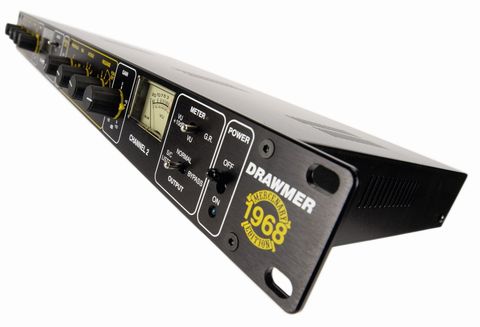Drawmer has the most instantly recognisable, generic appearance of any products in the industry, and the 1968 doesn´t stray from the trodden path. It looks like a Drawmer, and that´s almost enough said: at 1U it´s a hybrid of the ‘vintage´ look of the firm´s 60s range and the ‘classic´ look of their Pro series.
Like all their products, it´s solid and sturdily built. This new edition is designed primarily as a stereo mix compressor but at the same time is perfectly suited to individual instruments. Gone are the mic pre-amps and the DI section, and its size has been reduced to 1U to save rack space.
Drawmer are swimming against the tide of internal software mixing and a more obvious development would be to add EQ to the 1969 to capitalise on the front-end recording channel users. Clearly they wouldn´t take the opposite path without doing their research, so what´s the magic ingredient that´s going to make you want one of these over a handy and more affordable plug-in?
Well, like the 1969, the 1968 uses a J-FET gain reduction circuit. That´s a specialised solid-state design with attack times as fast, if not faster, than opto-isolator compressors such as the classic 1176. It´s a soft-knee compressor, so there´s no Ratio control and a variable Threshold governs the amount of compression relative to a fixed input level.
Output stage
The output stage uses a single 12AX7 valve that gives up to 20dB of gain make-up. Attack times range from 2ms to 50ms over six fixed settings, and Release times have three fixed settings (100ms, 500ms and 1sec) and three variable settings, depending on the signal input.
Sidechain access is provided by stereo jack sockets on the rear, allowing de-essing and other relative compression operations such as ducking. An internal frequency-conscious compression device called Big, which was first seen on the 1969, has been extended to each individual channel. This involves a High Pass Filter with a 100Hz roll-off applied to the sidechain, to prevent over-compression caused by the low frequencies of kick drums and bass parts. ‘Big´ refers to the fact that the sound stays much more consistent and open, rather than being pumped closed by heavy bass.
The two channels of compression can be used individually or in linked stereo operation, in which case the left channel controls both sides of the stereo set-up. The only other notably unusual feature is the +10dB VU meter switch, which adjusts the meters to show 10dB below normal level -- this is to take into account the high levels of stereo output signals these days. Usefully, the VU up-light glows red as the input signal approaches clipping.
Seeing as the 1968 is principally a stereo bus compressor, it makes sense to try it out across a whole mix with the Big mode switched in. Without much in the way of adjustments it's easy to be struck by the combination of openness and immediacy that it brings to the picture -- almost the sonic equivalent of expensive widescreen. Unfortunately, simple changes to any of the three main parameters has a severe impact and not necessarily for the better, especially, and not surprisingly, the Threshold.
Compression
Switching out Big has a profound affect on the size of the sound, completely justifying its moniker. It provides a very even and upfront high- and mid-range that´s utterly unaffected by the bass end, so you don´t get the vocal modulation that can be so off-putting.
As a drum bus compressor it's equally useful, particularly for a general tightening and warming of the whole kit -- though it isn't as good as some others for the more brutal drum compression some might want. Also, for some, the switchable attack settings might not be fine enough for precision drum compression.
One of the hardest instruments to compress well is an acoustic guitar and there's few compressors that can cut it; you invariably get an ugly attack envelope and high-end modulation. The 1968 is just great for it, however. The fast attack times and the Big setting ease the pain of all those side-effects and can make even a cheap acoustic sound classy. For vocals, the 1968 is up there with the best, giving a transparent but thoroughly controlled result on the two different singers it was tested with. The operation is so smooth you don´t hear it working, and the valve warmth and upfrontness easily get the close intimacy many love to hear.
Much has changed since the original 1960: its DI section impressed, but not much else. Thankfully the 1968 is light years better than the 1960 and on a level with all the great names of the past and present. Its smooth, transparent operation and warm open sound launch it into the top flight. Not only is it a fine mix compressor, with the Big setting living up to its name, but with its fast attack time it´s also great for vocals and acoustic instruments.
It´s certain to find appeal in major studios but -- as good as it is -- it's hard to see a wider base for a back-end processor, considering so many people are working entirely in Pro Tools for the convenience of recall. That said, for the well-oiled, it would marry up well to a pair of high-end mic amps and make a sublime recording path.


